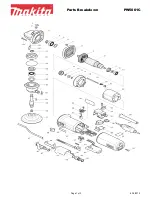
3
GB
mask, non-skid safety shoes, hard hat, or hearing prot
used for appropriate c
s will reduce
personal injuries.
c) Prevent uninten
st
g. Ensure the switch is in the o
ff
-
before c
g to power
source and/or ba ery pack, picking up or carrying the tool.
Carrying power tools with your
fin
ger on the
switch or energising power tools that have the switch on invites accidents.
d) Remove any adjus
key or wrench before turning the power tool on.
A wrench or a key le a ached
to a rota
part of the power tool may result in personal injury.
e) Do not overreach. Keep proper f
and balance a
This enables be er control of the power tool in unexpected situa
f) Dress properly. Do not wear loose clothing or jewellery. Keep your hair, clothing and gloves away from
moving parts.
Loose clothes, jewellery or long hair can be caught in moving parts.
g) If devices are provided for the c
of dust extr
and c
f
ensure these are
connected and properly used.
Use of dust c
can reduce dust-related hazards.
4) Power tool use and care
a) Do not force the power tool. Use the correct power tool for your applica
The correct power tool
will do the job be er and safer at the rate for which it was designed.
b) Do not use the power tool if the switch does not turn it on and o
ff
.
Any power tool that cannot
be controlled with the switch is dangerous and must be repaired.
c) Disconnect the plug from the
power source and/or the ba ery pack from the power tool before making any adjustments, changing
accessories, or storing power tools.
Such preven ve safety measures reduce the risk of st
the power
tool accidentally.
d) Store idle power tools out of the reach of children and do not allow persons unfamiliar with the power
tool or these ins
to operate the power tool.
Power tools are dangerous in the hands of untrained
users.
e) Maintain power tools. Check for misalignment or binding of moving parts, breakage of parts and any
other c
that may a
ff
ect the power tool’s opera
If damaged, have the power tool repaired
before use.
Many accidents are caused by poorly maintained power tools.
f) Keep cu
tools sharp and clean.
Properly maintained cu
tools with sharp cu
edges are less
likely to bind and are easier to control.
g) Use the power tool, accessories and tool bits etc. in accordance with these instruc ons, taking into
account the working c
work to be performed.
Use of the power tool for opera
ff
erent from those intended could result in a hazardous situa
5) Service
a) Have your power tool serviced by a
qualified
repair person using only iden cal replacement parts.
This
will ensure that the safety of the power tool is maintained.
SAFETY INSTRUCTION
GENERAL
• This
tool should not be used by people under the age of 16 years
• This
tool is not suitable for wet sanding
• N
ever use the tool when cord is damaged; have it replaced b
y a qualified pe
rson
• Do not
work materials containing asbestos (asbestos is considered carcinogenic)
• Al
ways disconnect plug from power source before making any adjustment or changing any accessory
ACCESSORIES
• MAXP
RO can assur
e fl
a
tool only when original accessories are used
• Do not
con
to use worn, torn or heavily clogged sanding discs
BEFORE USE
•
Always check that the supply voltage is the same as the voltage indicated on the nameplate of the tool
(tools with a ra
can also be connected to a 220V supply)
•
Avoid damage that can be caused by screws, nails and other elements in your workpiece; remove them
before you start working
• Use
completely unrolled and safe extension cords with a capacity of 16 Amps (U.K. 13 Amps)
• The noise l
evel when working can exceed 85 dB(A); wear ear prot
•
Du
st from material such as paint containing lead, some wood species, minerals and metal may be harmful






































